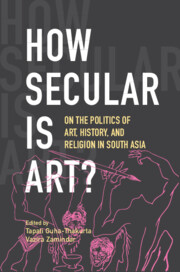4 - In Which Contemporary Indian Iconopraxis Devours Some Sacred Cows of Art History
Published online by Cambridge University Press: 21 February 2023
Summary
If this volume poses the question ‘How secular is art?’ in relation to South Asia, I want to insist that its stakes go well beyond art history in or for South Asia. For this question is an invitation to examine how art and art history are being reimagined from South Asia: how art history is becoming otherwise, albeit in ways that perhaps are not that other after all but were actually there all along. The unfinished business between ‘art’ and ‘religion’ is at the heart of this necessary reformulation. It pervades modern and contemporary art’s engagements with religious ‘living tradition(s)’ as it does secular institutions like museums. But it also surfaces in the peculiar habitations and uninhabitations of modern and contemporary art history by an ever-expanding domain of images varyingly contaminated by religiosity, spilling out from temples and shrines into homes and shops and onto streets and screens, embedded in the fabric of everyday life. These include the spectacular but temporary public deities of annual festivals such as Ganapati Utsav and Durga Puja; painted bazaar icons like those of Kalighat in Kolkata; the printed ones known as calendar art (Image 4.1); mythological television serials; the propitious adornment of vehicles of transportation (Images 4.2 and 4.3); monumental concrete icons delivering unsolicited darshan along highways (Image 4.4); and animated gifs showering blessings from WhatsApp. I am coming at art’s secularity and art history’s art via the affects and efficacies of these modern religious images, which may or may not, or sometimes do and sometimes don’t, also count as art.
In South Asia, innovative religious or mythological forms have been proliferating in response to new image technologies from the nineteenth century onwards, as described by a number of scholars including myself. Our accounts range across media from woodblocks, reverse glass painting, and history painting in oils to photography; chromolithography; offset printing; proscenium theatre; sculpture in clay, plaster, and other materials; cinema; television; various types of vehicle decoration (paint, hammered metal, carved wood, reflective tape); and reinforced cement concrete. The images described here either appear as central to the emergence of modernist art and cinema in South Asia, or as key to understanding religion, politics, public culture, or aesthetics in the region, or some combination of these.
- Type
- Chapter
- Information
- How Secular Is Art?On the Politics of Art, History and Religion in South Asia, pp. 91 - 122Publisher: Cambridge University PressPrint publication year: 2024



